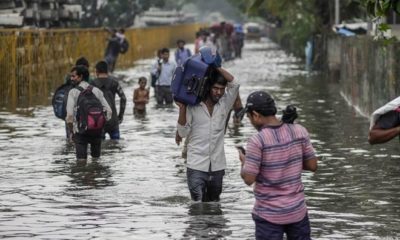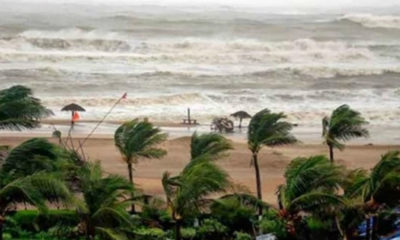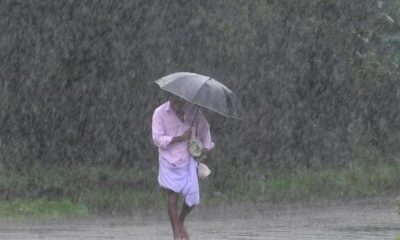Top News
Monsoon: Predicting an unpredictable climate system
 As news both good and bad pours from across India, the monsoon is once again in the limelight. From farmers, scientists and economists to astrologers, the monsoon has a significance unlike any other climate phenomenon in India.
As news both good and bad pours from across India, the monsoon is once again in the limelight. From farmers, scientists and economists to astrologers, the monsoon has a significance unlike any other climate phenomenon in India.
The monsoon provides around 80 per cent of the total rainfall in India. Getting monsoon predictions right occupies much attention of the weather department in India so that governments can make adjustments to their policies and prepare for droughts or floods according to the likely rainfall pattern.
However, the Asian monsoon, unlike its counterparts in West Africa and Australia, has been characterised by remarkable unpredictability and seasonal changes in wind direction and quantity and location of rain. Climate change due to global warming has added yet another dimension of unreliability to the monsoon. Understanding the timing, duration and intensity of the monsoon is vital if predictions of drought and flood are to be made.
Any marginal change, say a 5 to 10 per cent, in the total rainfall may appear to be small but these apparently small variations in the Indian monsoon can influence agricultural production and the stocks and commodities market in a big way. The variability of rainfall on shorter time scales has the biggest impacts.
For instance, intense heavy rainfall leads to flooding while the breaks in monsoon for over a week or more lead to water shortage and agricultural drought. Evenly distributed rainfall over the four monsoon months could be referred to as the best monsoon.
The variations in seasonal rainfall are often related to weather in other parts of the world, such as El Niño events in the Pacific Ocean. Simulations of future climate generally suggest an increase in monsoon rainfall on a seasonal mean, area-average basis.
This is due to the twin drivers of an increasing land-sea thermal contrast, but more importantly due to warming over the Indian Ocean which allows more moisture to be carried to India. Typically, increases in the total rainfall over India may be in the range of 5-10 per cent, although some climate models suggest more and some less.
The current climate models suggest greater variability in monsoon rainfall from year to year in a warmer world. In the future, it is expected that there will be extreme weather events with excessive rainfall in some years with low to very low rainfall in other years.
Most importantly, the regions that earlier experienced sufficient rainfall could face droughts while those that experienced lower rainfall could face floods frequently. The Indian summer climate in the coming century looks to be wetter on average, together with flood and drought conditions occurring more often.
It is important to build better capability to simulate the day-to-day and intra-seasonal variability of monsoon in climate models with more confidence in projections. In the future, increasing population along with various developmental priorities will bring additional stresses on society and the environment, with serious implications for water resources, health and food security.
Thus, the possibility that the monsoon may become less stable as a result of climate change has serious consequences for India.
There is an urgent need to improve the science of monsoon predictions and its applications. Such measures will help millions to adapt to emerging scenarios and tide over the predicaments of climate change. Using state-of-the art climate models and observations, researchers are investigating the processes that control the monsoon rain and its variability and it is hoped that accurate scientific predictions about the unpredictable monsoon will be possible in the near future.
Entertainment
Casino Days Reveal Internal Data on Most Popular Smartphones

International online casino Casino Days has published a report sharing their internal data on what types and brands of devices are used to play on the platform by users from the South Asian region.
Such aggregate data analyses allow the operator to optimise their website for the brands and models of devices people are actually using.
The insights gained through the research also help Casino Days tailor their services based on the better understanding of their clients and their needs.
Desktops and Tablets Lose the Battle vs Mobile
The primary data samples analysed by Casino Days reveal that mobile connections dominate the market in South Asia and are responsible for a whopping 96.6% of gaming sessions, while computers and tablets have negligible shares of 2.9% and 0.5% respectively.
The authors of the study point out that historically, playing online casino was exclusively done on computers, and attribute thе major shift to mobile that has unfolded over time to the wide spread of cheaper smartphones and mobile data plans in South Asia.
“Some of the reasons behind this massive difference in device type are affordability, technical advantages, as well as cheaper and more obtainable internet plans for mobiles than those for computers,” the researchers comment.
Xiaomi and Vivo Outperform Samsung, Apple Way Down in Rankings
Chinese brands Xiaomi and Vivo were used by 21.9% and 20.79% of Casino Days players from South Asia respectively, and together with the positioned in third place with a 18.1% share South Korean brand Samsung dominate the market among real money gamers in the region.
Cupertino, California-based Apple is way down in seventh with a user share of just 2.29%, overshadowed by Chinese brands Realme (11.43%), OPPO (11.23%), and OnePlus (4.07%).
Huawei is at the very bottom of the chart with a tiny share just below the single percent mark, trailing behind mobile devices by Motorola, Google, and Infinix.
The data on actual phone usage provided by Casino Days, even though limited to the gaming parts of the population of South Asia, paints a different picture from global statistics on smartphone shipments by vendors.
Apple and Samsung have been sharing the worldwide lead for over a decade, while current regional leader Xiaomi secured their third position globally just a couple of years ago.
Striking Android Dominance among South Asian Real Money Gaming Communities
The shifted market share patterns of the world’s top smartphone brands in South Asia observed by the Casino Days research paper reveal a striking dominance of Android devices at the expense of iOS-powered phones.
On the global level, Android enjoys a comfortable lead with a sizable 68.79% share which grows to nearly 79% when we look at the whole continent of Asia. The data on South Asian real money gaming communities suggests that Android’s dominance grows even higher and is north of the 90% mark.
Among the major factors behind these figures, the authors of the study point to the relative affordability of and greater availability of Android devices in the region, especially when manufactured locally in countries like India and Vietnam.
“And, with influencers and tech reviews putting emphasis on Android devices, the choice of mobile phone brand and OS becomes easy; Android has a much wider range of products and caters to the Asian online casino market in ways that Apple can’t due to technical limitations,” the researchers add.
The far better integration achieved by Google Pay compared to its counterpart Apple Pay has also played a crucial role in shaping the existing smartphone market trends.
Content provided by Adverloom

























